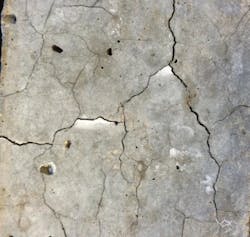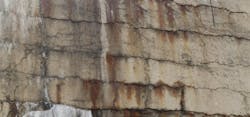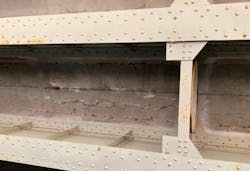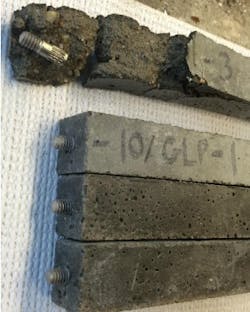Degradation of concrete structures from influence of aggressive chemicals
Typically, conventional concrete materials contain portland cement, coarse and fine aggregates, mineral or chemical additives, and water. Although the adhesion property and strength of concrete are obtained from the portland cement and its chemical hydration, the presence of various chemicals in the portland cement may cause deleterious distresses during the service life of the concrete structures. Aggressive materials from external sources such as deicers, sulfates, magnesium, etc. can also contribute to the degradation of concrete structures when they penetrate to concrete. Therefore, not only the diffusion of external aggressive chemicals needs to be prohibited, but also the likelihood of any deleterious reaction between the ingredients of concrete materials needs to be considered by the design team. Some of these deteriorations occur even decades after a concrete structure is in service. In this article, some of the most important distresses of concrete structures caused by aggressive chemicals are discussed.
Alkali-silica reaction (ASR)
Portland cement is made of various raw materials which are heated in rotary kilns during the cement production. The output of this process which is the portland cement contains very alkaline ingredients such as Na2+ and K+ which in presence of water and through the mixing process of the concrete, are released into the pore solution of concrete and create a high alkali environment. In such high alkaline environment, the embedded steel reinforcement passivates itself and prevents initiation of corrosion. If the aggregates contain reactive silicates, these silicates react with the alkali ions within the pore solution of the concrete and produce ASR gel. ASR gel in presence of moisture can swell and cause tensile stress throughout the concrete core, which results in cracks and deterioration.
Incorporation of non-reactive aggregates, low alkali portland cement, and supplementary cementitious materials (SCMs) are the three effective solutions to prevent ASR in new concrete structures. ASTM C1260, C1567, and C1290 are the three most well-known standard codes by which the ASR reactivity of aggregates as well as the mitigation performance of SCMs are evaluated before using them in concrete.
Elimination of external moisture infiltration, applying coating to the surface of the concrete structures, and treatment of the concrete structures with lithium are the three effective ways to suppress ASR damage in existing structures. Figure 1 shows map cracking caused by ASR on the surface of concrete.
Alkali carbonate reaction (ACR)
ACR occurs when certain types of dolomitic limestone aggregates are used in concrete in the presence of high alkali portland cement. The products of this reaction are expansive and cause deterioration of concrete. The type of aggregate used in the concrete is the way by which this distress is differentiated from ASR. ASTM C1778 is the standard test method to evaluate the ACR reaction.
Corrosion
As described above, due to the presence of high alkali ions in concrete’s pore solution which results in high pH of the concrete matrix, the steel reinforcement inside the concrete passivates itself by forming a passive layer at the perimeter of the steel reinforcement. This passive layer protects the reinforcement from chloride attack and corrosion. Once the pH of the concrete decreases, the concrete matrix is no longer in the alkali condition, so the passive layer at the perimeter of the reinforcement is destroyed. The existing reinforcement is now exposed to aggressive chemicals such as chloride ions. As soon as the chloride content at the level of reinforcement steel exceeds the threshold, the corrosion of the reinforcement is propagated, the corrosion products accumulate at the rebar’s interface and cause expansion and deterioration of concrete. Corrosion of the reinforcement is the most common type of concrete deterioration in bridges and marine structures.
The penetration of chloride ions (usually from deicers in bridge decks) along with the carbonation of the concrete are the two main reasons for decreasing the pH of the concrete. Carbonation of concrete occurs when carbon dioxide penetrates to the concrete surface and reacts with calcium hydroxide. This chemical reaction reduces the pH of the concrete and causes depassivation of the reinforcement.
To protect the existing and new concrete structures from carbonation distress, all the exposed concrete surfaces need to be coated to reduce the rate of CO2 penetration. In addition, incorporation of supplementary cementitious materials such as fly ash, slag and silica fume enhance the density and quality of the concrete and prevent CO2 penetration in new concrete.
To protect concrete structures from chloride attack, the top surface of the concrete slabs/decks needs to be coated/covered properly to decrease the penetration of chloride ions from deicers. Traffic coating membrane for parking garages and high-density concrete overlays for bridge decks can reduce the penetration rate of chlorides. If the existing concrete slab has exhibited corrosion of the reinforcement, cathodic protection and/or chloride extraction can be used to extend the service life of the structure. Figure 2 shows spalls, cracks and stains on the surface of a concrete bridge’s substructure. Figure 3 shows a crack at the soffit of a bridge’s concrete deck.
Sulfate attack
One of the components of the hydrated portland cement is ettringite, which is the mineral name for calcium sulfo-aluminate. The source for formation of this component is gypsum which is usually added to the portland cement to control the setting time of the concrete and give the construction workers some time to deliver and work with the concrete mixture. The formation of ettringite is an expansive process and occupies more space, which is okay if the concrete mixture is still in the plastic phase. Once the concrete turns to its solid phase, any internal expansion within the concrete matrix will increase the likelihood of distress since hard concrete members are not capable of resisting internal tensile pressure. Therefore, forming ettringite when the concrete is hard (during the service life of the structure) is not acceptable.
Sulfates from external sources like water or soil penetrate the concrete and react with monosulfate which is one of the cement’s hydration products. The product of this reaction is ettringite and as mentioned above can expand and cause damages.
The most effective ways to prevent sulfate attack in new structures are using high quality concrete (with low water-to-cement ratio and/or SCMs) and/or Type II or V cements. ASTM C1012 is the standard code to evaluate the expansion of mortar specimens exposed to sulfate solutions. Figure 4 shows deterioration of a mortar specimen that was exposed to sulfate solution for a period of time (the specimen is at the top of the image). Note that the specimens that contained SCMs did not exhibit any damage (three intact specimens in the picture).
Delayed ettringite formation (DEF)
The other common form of sulfate attack is called delayed ettringite formation (DEF) which is more common in precast concrete manufacturing. Unlike the sulfate attack mentioned above where the source of the reaction is external (sulfate from soil or water), the sulfate source for DEF is internal, and no external source of sulfate is required to trigger the reaction. To achieve a certain amount of strength in a short period of time, the precast manufacturers desire to increase the curing temperature of the precast elements. At high exposure temperature (i.e., above 65° C), the existing ettringite within the concrete matrix is not stable any more. Therefore, the sulfate ions form the existing ettringite are released into the concrete matrix. These released sulfates later will react with the hydration products of portland cement and form secondary ettringite. As mentioned above, when the concrete is hard, any formation of ettringite causes internal pressure and distresses which is called DEF damage.
The effective ways to prevent DEF damages in precast elements are limiting the exposure temperature during the curing process to prevent ettringite’s decomposition as well as using an air entraining agent in concrete to create voids for secondary ettringite to accumulate.
Acid attack
Two main components of portland cement’s hydration are calcium silicate hydrate (C-S-H gel) and calcium hydroxide (Ca (OH)2). C-S-H gel occupied most of the paste matrix and is responsible for concrete’s mechanical and durability properties. Calcium hydroxide occupies approximately 25% of the concrete paste volume and is not as effective as C-S-H to provide strength for concrete. As mentioned before, the alkali ions from portland cement along with the calcium hydroxide are the reasons for high pH of the concrete materials. External concentrated acids penetrate the concrete, react with calcium hydroxide, and form salt and water which can leach out from the surface of the concrete and negatively affect both the mechanical and durability properties of concrete.
Sulfuric acid is the most severe type of acid which causes both dissolution of the calcium hydroxide as well as sulfate attached (due to the presence of sulfate ions). Any solution to prevent penetration of aggressive materials into the concrete can reduce the likelihood of acid attack. In addition, incorporation of SCMs enhances the quality of concrete and consequently prevent the acid attack.
Salt attack
Salt attack occurs when the exterior surface of the concrete structure is exposed to water that contains salt. Once the water evaporates, salt remains on the surface of the concrete and causes pressure and damage. Applying sealer to the face of the concrete and using high quality concrete can mitigate salt attack.



